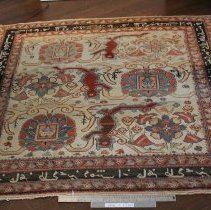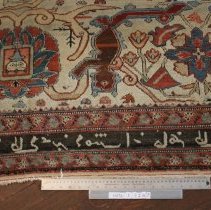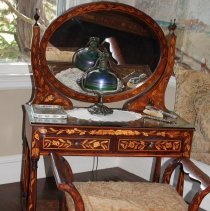Object Search Record
Images



Metadata
Catalog Number |
1976.1.1263 |
Object Name |
Rug, Throw |
Date |
1930s |
Description |
Square Persian rug at one time fringed on 2 ends. The background is beige with a coral border. An inner dark border has Arabic lettering on all four sides. The following description is from an appraisal done by Raymond Hayes, Rare Oriental Rugs, 17 Coolidge Street, Brookline, Mass. The appraisal is addressed to Mrs. Wm. L. McKee and is not dated. Based upon the format of the telephone number and knowledge of the McKees' financial situation, it is believed the date is early 1930s. "An antique over one hundred years old. This rug is a reproduction of a rug probably over one thousand years old. In northern India, Persia, Kurdistan and Caucasia there is a sect of devil worshippers known as Yezides but their number is small, and about their religion and rites very little is known in this country. The emblems of the faith, however, are supposed to be peacocks, dragons, snakes and owls. Their religion s believed to embrace certain Christian teachings together with their own peculiar doctrines. The field of the rug is of different shades of ivory or cream white. The ornamentation consists of three monkeys in brownish red outline in blue and gold; three double headed dragons in gold oulined in red and three rosettes in the same redish [sic] brown as the monkeys, containing floral lily figures in blue. There are also three rosetts [sic] containing a square in gold and red , which in turn contains what is either a gargoyle, a mask or an owl's head. There are also three double tree of life designs in gold, red and gold, containing a gold Swiss cross. The inner and outside border with guard lines of white dots on black, is on a red field with floral ornamentation of pansy design in white, blue and black. There is also a serrated border in blue, white, gold and red, bordering the white field of the rug. The main border is on a natural brownish black wool field, and contains inscriptions running all around the rug, the same inscription being repeated on the four sides of the rug. The writing is a combination of Persian and Arabic and it relates to the presentation of the rug to the famous old Persian warrior, statesmand and poet, Hatim Tay, who lived at about the time of Modhammed, 600 A.D. The translation of the inscription is to the effect that the rug was presented to Hatim Tay with best wishes for his good luck, health and prosperity. The upper and lower ends of the rug have been restored but the work has been so perfectly done that it is almost impossible to distinguish it from the original weave. In nearly forty years' association with rugs I have never seen anything of the character of this rug. It is a wonderful old antique in perfect condition, beautiful colors and very fine weave. It is a museum specimen. it could never be replaced. If it were three or four hundred years old, ranking with the Ispahan and old Ghiordes rugs, it would be even more priceless than rugs of these types today because while such pieces are rare they do reach a collector's market and there are rugs of these types in most fine collections. I doubt very much if any Yezides rugs of the character of this piece exist in the world today. If it were my property I would never dispose of it. 225 knots." |
Materials |
Wool |
Condition |
Good |
Search Terms |
Household Goods Rug Persian rug Animal Animal, Monkey Bird Bird, Owl |
Catalog Sub-category |
Floor Covering |
